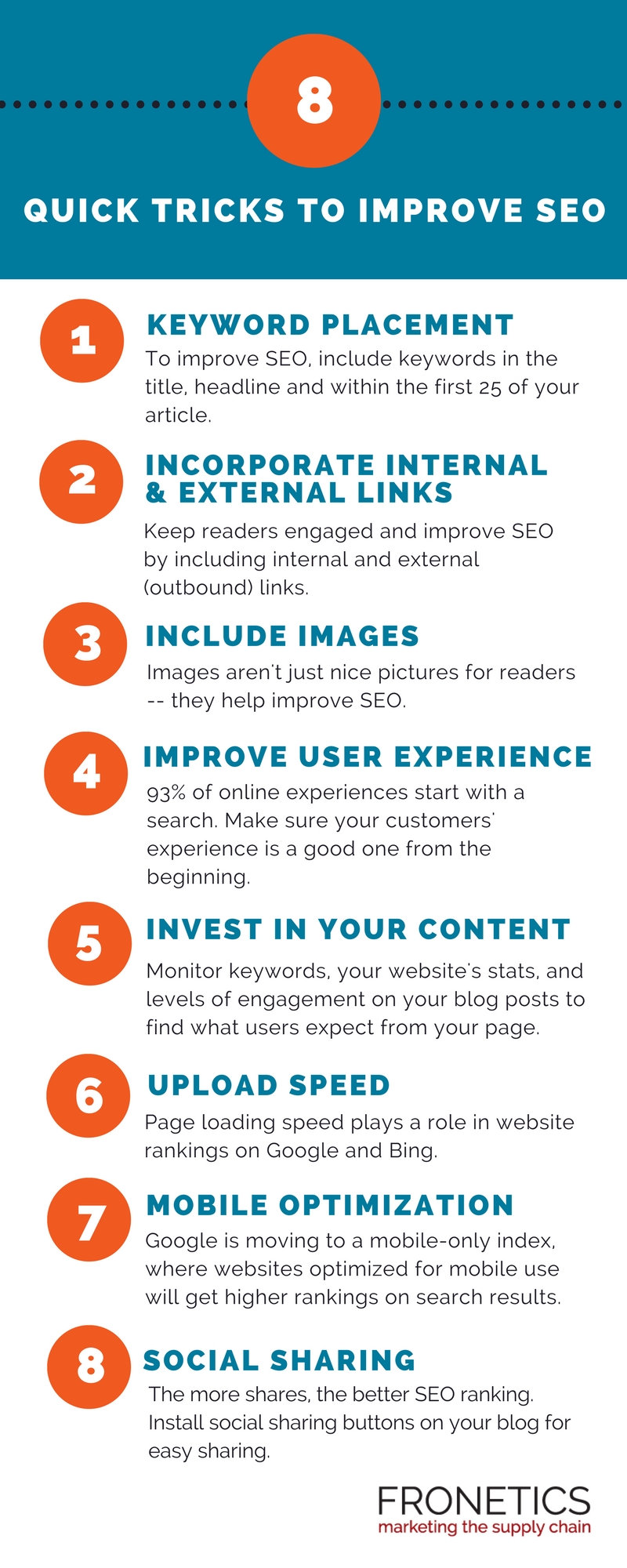
by Fronetics | Jan 29, 2018 | Blog, Content Marketing, Logistics, Marketing, Supply Chain
Use these 8 quick tips in your blog posts to improve SEO and help your target audience find your content.
Search engine optimization: It’s a phrase every blog writer looking to grow readership has wrestled with at one time or another. Part science, part art, SEO writing can evade even the most seasoned blogger. You want people searching the internet to find your blog, but you also want readers to enjoy your posts and not feel like they’re written for machines.
Search engines continue to evolve and improve their algorithms to make sure readers are finding exactly what they’re looking for. Never artificially stuff your posts with keywords, links or images. Search engines, like Google, penalize webpages that use sneaky techniques, like keyword stuffing, by demoting or even removing their pages from their indexes.
Ultimately, if you want to improve your SEO, your content needs to be value to your target audience. That should be your priority when planning and producing content like blog posts. But you can also keep these quick tricks in mind to optimize your posts, and thus increase the likelihood internet searchers will find them in the first place.
Infographic: 8 quick tips for blog posts to improve SEO

(Made with Canva)
Using these 8 quick tips will improve SEO and get your blog posts in front of your target audience. Remember, your best bet on moving up on search engine results pages is to create content that readers want to read. Sounds simple, I know, but it can be challenging. Let us know how these tips helped improve your SEO.
Related posts:

SaveSave

by Fronetics | Jan 25, 2018 | Blog, Content Marketing, Marketing
Why is no one reading your blog? Chances are, you’re not doing it right. Here are some of the blog writing mistakes you may be making.
There is so much content out there. In fact, the U.S. alone generates 2,657,700 gigabytes of internet data every minute. Every minute! That’s a whole lot of videos, tweets, posts, and photos being shared online. No wonder no one is reading your blog.
There’s so much competition out there, it’s hard to stand out against those numbers. Even with the time and energy you’re putting into your blog, you’re not seeing the views and engagement you were hoping to achieve.
Most likely, you are making one of these mistakes. Here are some reasons why no one is reading your blog.
10 reasons why no one is reading your blog: an infographic

(Made with Canva)
Related posts:

SaveSave
SaveSave
SaveSave
SaveSave

by Fronetics | Jan 24, 2018 | Blog, Content Marketing, Current Events, Logistics, Marketing, Social Media, Strategy, Supply Chain
Companies in the supply chain and logistics industries should take note of these top social media trends in 2018.
While we don’t know what 2018 has in store for companies in the supply chain and logistics industries, we do know change is coming. That is true not only in terms of the economy and your business, but also for the marketing tools you use. Of course, ever-evolving social media platforms are an important part of that.
We already know that Facebook News Feed will be making some big changes this year. What other platforms or types of media will be hot? What will your industry peers and competitors be trying in 2018? As we dive into the new year, it’s important to be aware of the social media trends that will dominate the next 12 months so you can incorporate them where you are able.
As always, good content will be as important as ever. With over one million new-data-producing social media users each day, high-quality content is the only way to stand out from the masses. But we also think you should pay attention to a few social media trends that we have highlighted in the following video. We’re certainly planning to adjust our strategy and those of our clients to consider these things.
As you start to strategize for 2018, and beyond, be sure to consider these social media trends in your content marketing plans.
Top social media trends for 2018
Make sure to follow our blog for our monthly social media news posts to stay updated on the latest platform updates. And feel free to reach out to us with questions or if you would like to see a certain social media trend covered on our blog.
Related posts:


by Fronetics | Jan 23, 2018 | Blog, Content Marketing, Marketing
Measuring the success of your content is important in evaluating your writing for SEO strategy. Here’s how to do that.
This week, we’re wrapping up our series on writing for SEO. In this series, we’ve explored how search engines are changing, how people are changing the way they search, and how to make use of topic clusters and pillar content. Now, with a better understanding of the changing SEO landscape, it’s time to think about how to measure the success of your content.
As with any marketing effort, having a documented strategy for your content’s search engine performance — and a plan for measuring the success of your strategy — is key. You might be asking yourself, “How do I measure the success of a piece of content?”
Should I measure the success of one post at a time?
When it comes to SEO, the answer to this question can be complicated, largely because it’s not a great idea to evaluate the success of your campaign on a post-by-post basis. It’s too narrow a definition of success to account for the complex network of direct and indirect benefits of effective SEO writing.
Take brand-driven content, for example. Your focus isn’t about generating individual sales, but rather about elevating your brand, raising wider awareness, attracting new talent, or generating backlinks. If you based the success of brand-driven content on the number leads it generated alone, you’d think it was performing terribly. But your post may, in fact, have generated hundreds of backlinks and be getting lots of traffic.
Evaluating by cluster topic
So how do you evaluate success? Rather than looking at your content on a post-by-post basis, consider how all the content under each cluster topic performs as a whole.
According to HubSpot, “Measuring the entire topic cluster against all of your core business metrics will enable you to include residual benefits coming from content that doesn’t align with direct conversion goals.”
As you look at the performance of your topic clusters, consider the following four questions:
- Which topics perform best at driving traffic to your website or other web presence?
- Which topics earn you the most leads?
- Which topics drive the most revenue for your business?
- Which topics earn the most backlinks/coverage?
It’s important to remember that at the end of the day, what you’re working toward — and what will work best for your search visibility — is creating content that people want to see. Writing for SEO is ultimately about creating better content, increasing search engine visibility, and providing the best possible experience for your site visitors.
Related posts:


by Fronetics | Jan 22, 2018 | Blog, Content Marketing, Marketing
Automation is an excellent tool for marketers, but keep these things in mind when incorporating automation in email marketing.
I recently wrote about a new marketing trend all supply chain marketers should be paying attention to: marketing automation. One area where marketing automation can be particularly helpful is in email marketing.
Marketing automation software can improve your lead-nurturing process and make you more efficient. It can help you provide more personalized experiences for your prospects through email. It can also save you a significant amount of time, as you won’t have to create individual emails each time a particular prospect takes a particular action.
But be wary. Not everything can, or should, be automated or scheduled in advance. As you begin to incorporate automation in email marketing, here are 5 tips to get you started.
5 tips for using automation in email marketing
1) Segment your email list.
Email list segmentation allows you to customize your subscribers’ experiences by only sending emails to certain people based on different criteria. There are millions of ways to segment your list: when someone joined the list, what emails they’ve opened, their demographics, etc. This way, you can provide the most relevant communication to your prospects, keeping them invested — and keeping you out of their spam folder.
2) Timing is everything.
What you might notice is that segments of your list respond more positively at different times. Automation software allows you to take advantage of that, automating email blasts to correspond with the preferences of your subscribers.
3) Text is your friend.
It’s a sad fact that all that time you spend creating beautifully designed images to accompany your email content is wasted. Most of your subscribers will be using email programs that block out additional images. Focus on providing the most relevant, quality content instead.
4) Narrow down your list.
It might seem great to have a large subscriber list. But it’s the number active subscribers, rather than the total number of subscribers, that matters. Refining your email list should, therefore, be an ongoing process. Good news: It’s a task you can automate.
For example, send a “break up” email to members of your list that haven’t opened your emails in a while. If they don’t reply or open it, it’s safe to remove them from the list. It’s also important to make it easy for subscribers to opt out at any time.
5) Keep your finger on the pulse.
This is all about asking your subscribers what they want. It may seem obvious, but this all-important step is often overlooked. As soon as a new subscriber joins your list, they should be receiving an email asking them why they signed up for your email list. If you pay attention to the answer, you’ll now how to segment the new subscriber, which in turns ensures that they get the most individual experience, and cultivates a lasting relationship.
How do you use automation in email marketing?
Related posts:

SaveSave
SaveSave

by Fronetics | Jan 18, 2018 | Blog, Content Marketing, Marketing
With a high correlation between publishing frequency and web traffic and leads, you need to publish blog content more often to boost lead generation efforts.
Here are Fronetics, most of our clients are sales-driven. If a client’s business goals include earning leads, we are sure to align the client’s content strategy with that objective. One of the most effective ways to increase the number of leads your website attracts is to increase the frequency with which you publish content.
It seems simple, right? The more often you publish blog content, the more traffic and leads you’ll get. Search engines consider posting frequency in their rankings. What’s more, every time you post, you create a new opportunity to be found, shared, and linked by other sites.
The more you publish blog content, the more they’ll read.
Recent studies have shed light on the relationship between publishing frequently and increased web traffic and leads:
- HubSpot’s benchmarking data shows that blogs that publish 16+ times per month receive 3.5x more traffic than those that publish weekly or less often.
- From the same report, companies that publish 16+ blog posts per month get about 4.5X more leads than companies that publish between 0-4 monthly posts.
- Curata’s survey of 400+ marketers found that 90.5% of the most successful business blogs (over 10,000 views per month) publish at least once a week.
But we know there are challenges to posting frequently.
Publishing blog content frequently comes with its own set of challenges. Time is the biggest obstacle we hear from our clients. Good blogging should be more of a conversation than a press release, but dialogue takes time to create. It can also require additional time to respond to readers’ questions and comments.
The other big challenge is quality. When you’re producing more and more content, it’s easy to let the quality of your pieces slip. You want to make sure the content on your blog is relevant, informative and engaging. It can be difficult to balance publishing frequently and maintaining value and quality.
So how do you find the balance?
Start small. We often encourage our clients to publish blog content just one more time per week. Though some are skeptical of the impact this will have on their traffic and lead-generation efforts, they inevitably find that such a small step can make a big difference.
And no, you don’t have to be a Fortune 500 company to start seeing the impact of your blog posts on your leads. The HubSpot benchmarking report found that increasing posting frequency had the biggest impact on smaller businesses: Companies with 10 or fewer employees that published 11+ posts per month had almost 3X more traffic than companies publishing 0-1 monthly posts, and about 2X as much traffic as those publishing 2-5 monthly posts.
Take one client of ours for example. We suggested moving from publishing one post to two posts per week. The client was unsure this would have any impact, especially for a company in the supply chain industry. But the immediate results spoke for themselves. After just one month, traffic increased by 23%, sales leads doubled, and the client landed a new customer.
Try our suggestion and publish blog content one more time per week, then let us know how it works out for you. We’d love to hear about your success.
Related posts:
SaveSave










